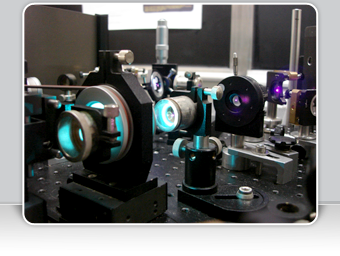« Back to all publications
Download this list in a RIS file or a BIB file or a PDF file
|
||||||||
A spectroscopic and kinetic study of the photoinduced electron transfer (ET) reaction between 9,10-dicyanoanthracene (DCA) and 1-methylnaphthalene (MNA) in acetonitrile using the transient grating technique is reported. Apart from the bands assigned to 1DCA* and DCA•-, the transient spectrum exhibits a band located at 580 nm and ascribed to MNA2•+. This species is generated upon reaction of a second donor molecule with a 1:1 complex to form a 1:2 complex (DCA•-·MNA2•+). Using chloranil as electron acceptor, the rate constant of this reaction has been measured to be 6.8 × 109 M-1 s-1. From the donor concentration dependence of the kinetics of DCA•- diffraction intensity and of the free ion yield, the rates of back ET to the ground state within the 1:1 and the 1:2 complexes have been determined to be equal to 1.8 × 108 and 16.9 × 108 s-1, respectively, while their rate constants of separation into free ions are 1.6 × 108 and 1.1 × 108 s-1, respectively. These values have been obtained assuming a reaction scheme in which both forward and backward ET essentially take place at contact distance. In the case of the 1:1 complex, however, charge recombination within a loose ion pair cannot be ruled out. | ||||||||
|
||||||||
The luminescence of the scorpion's outer shell has been shown to be due to fluorescence of very short lifetime (nanoseconds). The emission and excitation spectra have been determined, and the potential biological significance of this photoluminescence is discussed. | ||||||||
|
||||||||
The reliability of the transient grating technique to determine the energetics of processes following second order kinetics, such as free ion recombination, is investigated theoretically. As the second order process takes place, the grating of the reactant population becomes anharmonic, complicating the determination of the population dynamics from the time profile of the diffracted intensity. However, the thermal phase grating is anharmonic from the beginning of the reaction, but is harmonic when the process is completed. As a consequence, the energetics of the reaction can be deduced accurately from the maximum amplitude of the diffracted intensity without having to take the anharmonicity of the grating into account, as long as thermal diffusion is slow. To achieve this, the crossing angle of the pump pulses on the sample has to be smaller than 1°. Otherwise, an arduous fitting procedure is required to extract the energetic parameters from the experimental data. | ||||||||
|
||||||||
A study of the dynamics of ground-state recovery of the perylene radical cation (Pe•+), of perylene radical anion (Pe•-), and of anthraquinone radical anion (AQ•-) is reported. In boric acid glass, the excited-state lifetime of Pe•+ is 35 ± 3 ps, while in concentrated sulfuric acid, it is smaller than 15 ps, the time resolution of the experimental setup. The excited-state lifetime of Pe•+, Pe•-, and AQ•- generated by photoinduced intermolecular electron-transfer reaction in MeCN is shorter than 15 ps. In the case of Pe•-, the uncomplete ground-state recovery is ascribed to the occurrence of electron photoejection. The free ion yield in the intermolecular electron-transfer reaction between 9,10-dicyanoanthracene (DCA) and two electron acceptors was measured in a two-pulse experiment, where the second pulse excited the ensuing DCA•-. This excitation has no influence on the magnitude of the free ion yield, indicating a short excited-state lifetime of DCA•-* relative to the time scale of back electron transfer and ionic dissociation. A red emission, ascribed to the fluorescence of protonated Pe, was detected in boric acid glass and sulfuric acid. No fluorescence that could be clearly ascribed to Pe•+* could be observed. | ||||||||
Download this list in a RIS file or a BIB file or a PDF file
Contact:
Eric Vauthey
Physical Chemistry Department - Sciences II - University of Geneva
30, Quai Ernest Ansermet - CH-1211 Geneva 4 (Switzerland)
© All rights reserved by Eric Vauthey and the University of Geneva
Design and code by Guillaume Duvanel




